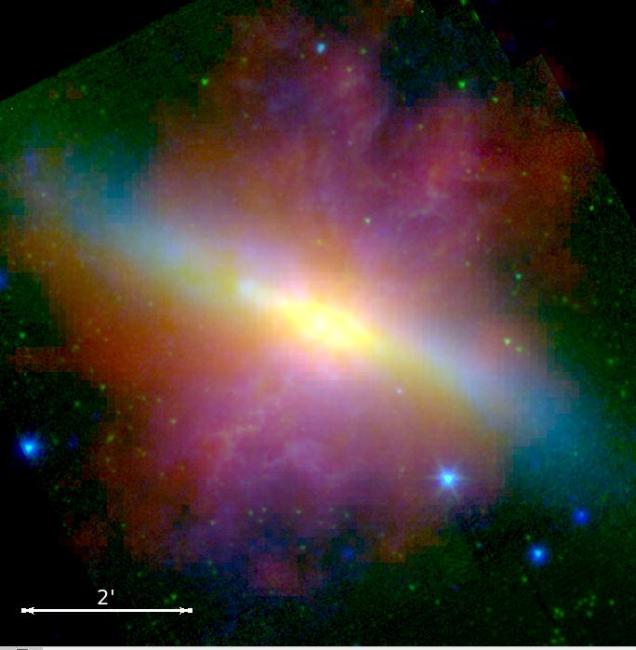
An image of the active star-forming galaxy M82 at three wavelengths: UV (blue), near-infrared (green) and far-infrared (red). New research indicates that even in the early universe galaxies actively forming stars do so in the same general way, modulated by the amount of gas and dust they contain.
Ten billion years ago or so, at least according to the current picture, the youthful universe began to produce an abundance of new stars. The very first ones appeared in the young cosmos after only a few hundred million years, but they were unlike stars of today. The universe back then contained almost no elements other than hydrogen (and some helium), and so these first stars contained mostly hydrogen and were very massive. By the time a few billion years had passed, however, this first generation of stars had manufactured many other elements that
enriched the natal gas. These elements could help the gas cool as it compressed, and so they aided gravity as it collapsed
material to form a wide range of new stars, many of them similar to the Sun. After a few billion years, galaxies acquired their mature forms and were populated by nearly normal stars. Then, for reasons
that are not understood, they began making stars at unprecedentedly high
rates.
Astronomers gazing at distant galaxies find that those whose light has been traveling towards us for between nine and eleven billion years show dramatic increases in star formation, about ten times more active than what we see today. The evidence comes from these
galaxies' luminosities and copious ultraviolet radiation, both earmarks of new stars. This general story has been known for about ten years, but there have always been questions about it because distant galaxies are faint and therefore hard to see. Perhaps only the most unusual bright
galaxies in this epoch are undergoing such starbursts?
SAO astronomer Ho Seong Hwang, together with a team of 13 colleagues,
wanted to answer this question. First, they had to have a clear understanding of what drives star formation in galaxies in the first
place. They argued in their prior research (consistent with other research programs) that the presence of abundant, molecular gas in dense clouds was the key to regulating star formation in normal galaxies. But measuring the molecular gas content is not always so easy, especially in
more distant galaxies, because light from the gas – sampled by the millimeter emission of carbon monoxide – can be faint. However, the scientists found that infrared emission by dust, as seen with the
Herschel Space Observatory, is bright - and also a good tracer of molecular gas.
In a new paper in the Astrophysical Journal, the scientists extend their
analysis to galaxies so far away that their light has been traveling for over ten billion years. Analysis of the infrared observations of these galaxies shows that in nearly all cases their emission has the same general spectral character -- the only correction needed is for the amount of dust, and not (for example) in the way stars are made. The scientists demonstrate for the first time that the infrared dust emission can predict the gas, and hence estimate the star-forming activity. The reason, then, that distant galaxies are so luminous is because they lack many elements and their gas and dust are thereby deficient. That deficiency results in brighter star formation emission.
Related News
CfA Celebrates 25 Years with the Chandra X-ray Observatory
The Radcliffe Wave is Waving
Distant Stars Spotted for the First Time in the Vast Magellanic Stream
Billions of Celestial Objects Revealed in Gargantuan Survey of the Milky Way
Did Supernovae Help Form Barnard's Loop?
The Magnetic Field in Milky Way "Bones"
The Role of Turbulence in Making Massive Stars
Dust Grains from Supernovae
Cold Molecular Clouds as Cosmic Ray Detectors
Scientists Uncover Warehouse-Full of Complex Molecules Never before Seen in Space
Projects
AstroAI
GMACS
For Scientists